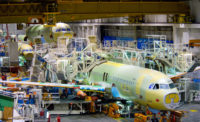New Sensors Detect Disruptions in Assembly Operations at Airbus

HAMBURG, Germany—Automated assembly operations of the future will increasingly rely on close collaboration between humans and machines. Engineers at the Fraunhofer Institute for Factory Operation and Automation (IFF) are working with Airbus to learn how to detect and predict disruptions in aircraft production. They are focusing on the installation of jetliner cabin doors.
“We want to find out how we can automate and make our assembly process more streamlined,” says Eugen Gorr, an engineer in charge of the development of innovative assembly operations at Airbus’ Hamburg operations. “The operations surrounding the installation of a cabin door are particularly well suited for ascertaining which data we collect how and where, how we process them, and how we can feed them back into the assembly process in real time.
Fraunhofer IFF’s new sensor and data processing concepts are intended to enable optimized process monitoring and its incremental integration in the assembly environment.
The R&D project focused on the material delivery unit (MDU) that transports a door from the supplier to the fuselage on the Airbus assembly line. It was equipped with diverse sensors and data storage systems that supply engineers with relevant information anytime and anywhere during the entire operation.
The engineers were looking for answers to questions such as: for which airplane is the door intended? Is it a left or a right door? Did anything unusual happen during its transport that requires reinspection before installation? Has the door warmed up to the temperature of the fuselage?
“Until now, communication in assembly plants has been based more on paper documents and word of mouth, and less on digital aids,” says Martin Woitag, a research scientist in Fraunhofer IFF’s Measurement and Testing Technology Business Unit. “And since feedback on the current stage of manufacture is given only once a week, it is significantly decoupled from the time of its completion.”
Woitag and his colleagues developed a mobile sensor dubbed AirBOX. It infers relevant information from the collected data without delay in a flexible network.
“The amount of data transmitted remains so small that the wireless network in the assembly plant is not utilized more than necessary,” explains Woitag. “The AirBOX can be configured so that additional modifications in the existing infrastructure are unnecessary. It is also highly compatible with other systems.
“Although it tracks the cabin door’s location and temperature continuously, it does not send a signal to the server until the sensor data include two criteria, the correct installation location and attainment of room temperature,” notes Woitag. “Only then is the cabin door ready for installation, because it has not only been delivered but also warmed up to the temperature of the fuselage. In principle, one single bit of data suffices to notify Airbus of this event.”
The sensor data and events are stored in a local database and visualized on the web. Up to six automatically recognized and preconfigured sensors can be connected to the box to build a sensor network.
“The AirBOX opens an abundance of digitalization options that support manufacturing operations,” claims Woitag. “[In the future], it could play a role in the development of a visual assistance system for wing and fuselage assembly.”
Looking for a reprint of this article?
From high-res PDFs to custom plaques, order your copy today!



